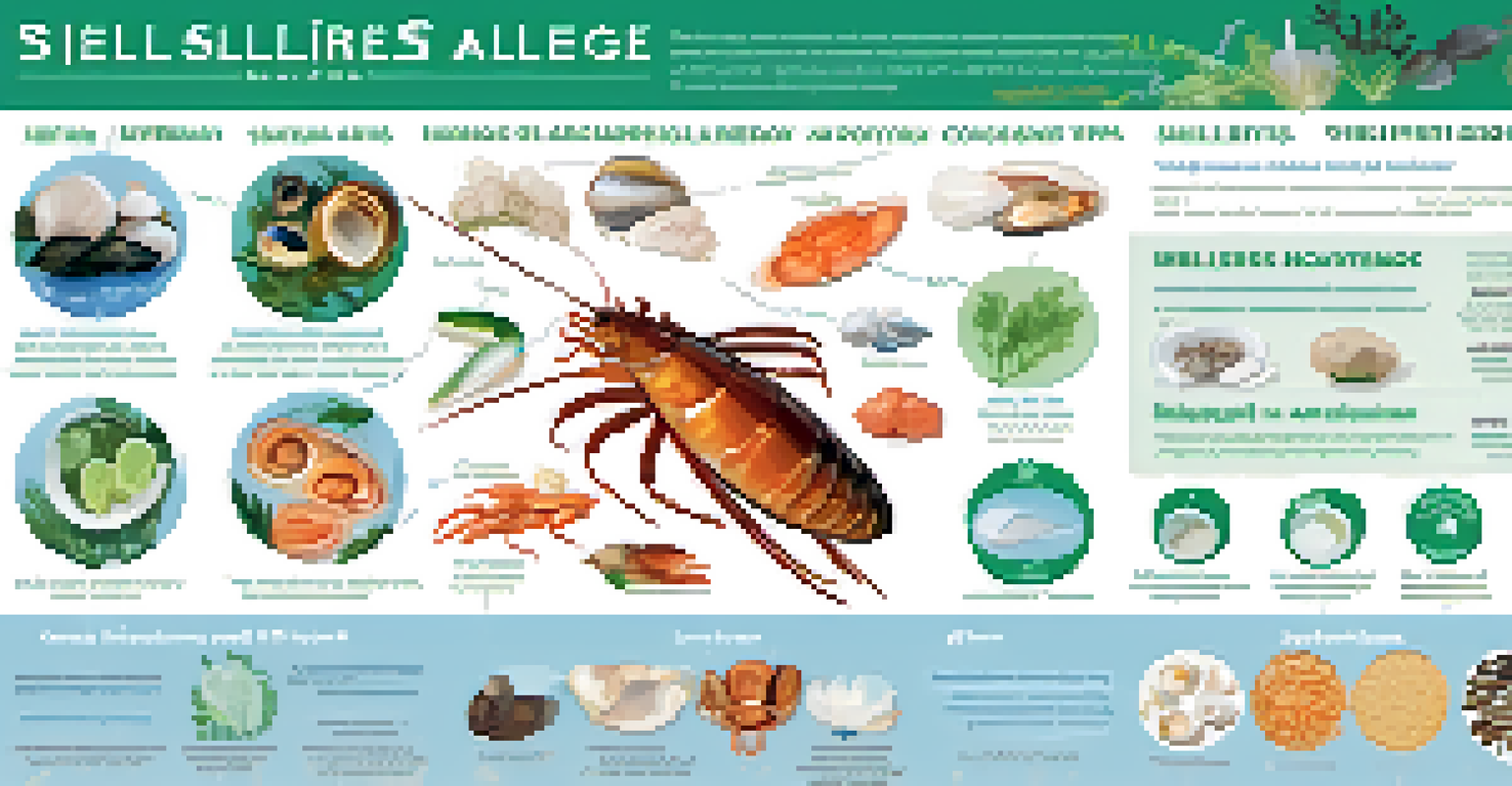Understanding Shellfish Allergies: Symptoms and Management

What Are Shellfish Allergies and Why Do They Occur?
Shellfish allergies are among the most common food allergies, affecting millions worldwide. They occur when the immune system mistakenly identifies proteins in shellfish as harmful, triggering an allergic reaction. This allergy can be divided into two main categories: crustaceans, like shrimp and crab, and mollusks, such as clams and oysters.
Food allergies are not just an inconvenience; they can be a matter of life and death.
Understanding the underlying causes of shellfish allergies is crucial. Genetics plays a significant role, as individuals with a family history of food allergies are more at risk. Additionally, exposure to shellfish at a young age may influence the likelihood of developing an allergy, although this is still a topic of ongoing research.
Awareness of shellfish allergies is essential for prevention. Even a small amount of shellfish can provoke a severe reaction in sensitive individuals. This makes it vital for those with allergies to be vigilant about the foods they consume and to educate themselves about the potential sources of shellfish.
Recognizing Symptoms of Shellfish Allergies
Symptoms of shellfish allergies can vary widely from person to person. Common reactions include hives, swelling, stomach cramps, and nausea, which can occur within minutes of consuming shellfish. In some cases, individuals may experience more severe symptoms, such as difficulty breathing or anaphylaxis, which is a life-threatening reaction requiring immediate medical attention.

It's important to note that symptoms may not always appear immediately. Some individuals may experience a delayed reaction, making it harder to identify the trigger. Keeping a food diary can help track symptoms and identify potential allergens, which can be a useful tool for both individuals and healthcare providers.
Understanding Shellfish Allergies
Shellfish allergies occur when the immune system mistakenly identifies shellfish proteins as harmful, often influenced by genetics and early exposure.
If you suspect you have a shellfish allergy, consult with a healthcare professional for proper testing. Skin prick tests or blood tests can help determine your allergy status and guide you on appropriate management strategies.
The Role of Diagnosis in Shellfish Allergies
Diagnosing a shellfish allergy typically involves a combination of medical history, symptom review, and allergy testing. Healthcare providers may first assess your symptoms and any family history of allergies. This initial evaluation is crucial in determining the best course of action.
An ounce of prevention is worth a pound of cure.
Allergy tests, such as skin prick tests or specific IgE blood tests, can provide valuable information about your sensitivity to shellfish proteins. These tests help differentiate between true allergies and food intolerances, which can present similar symptoms but may not involve the immune system.
A confirmed diagnosis allows for more effective management of the allergy. Knowing exactly what triggers your reactions can empower you to avoid shellfish and minimize the risk of future allergic responses.
How to Manage Shellfish Allergies Effectively
Managing a shellfish allergy primarily revolves around avoidance. This means steering clear of all types of shellfish, including crustaceans and mollusks, as cross-contamination can occur easily. It's essential to read food labels carefully and communicate with restaurant staff about your allergy when dining out.
In addition to avoidance, having an action plan in place is crucial. For those with severe allergies, carrying an epinephrine auto-injector (EpiPen) can be life-saving in case of accidental exposure. Make sure to educate friends, family, and coworkers about your allergy and how to use the EpiPen if needed.
Recognizing Allergy Symptoms
Symptoms of shellfish allergies can range from mild reactions like hives to severe responses such as anaphylaxis, which require immediate medical attention.
Regular follow-ups with your healthcare provider can help you stay informed about your allergy. They can provide guidance on any new treatments or advancements in allergy management, ensuring you have the best resources at your disposal.
The Importance of Label Reading and Awareness
Label reading is a critical skill for anyone with a shellfish allergy. Many packaged foods may contain shellfish or be processed in facilities that handle shellfish, increasing the risk of cross-contamination. By carefully checking ingredient lists, you can protect yourself and make informed dietary choices.
Some foods may contain hidden shellfish ingredients, such as seafood sauces or flavorings. Being aware of these potential pitfalls can help you avoid accidental exposure. When in doubt, it's best to contact the manufacturer for clarification on ingredients.
Awareness doesn't stop at food labels; it extends to educating yourself about shellfish in everyday situations. Understanding where shellfish may be present, like at seafood markets or buffets, will help you navigate social settings more confidently.
Living with Shellfish Allergies: Tips and Support
Living with a shellfish allergy can be challenging, but there are strategies to make it easier. Joining support groups or online communities can provide a sense of belonging and access to shared experiences. Connecting with others who face similar challenges can be incredibly reassuring.
Cooking at home allows for full control over ingredients and reduces the risk of accidental exposure. Experimenting with shellfish substitutes, like plant-based seafood alternatives, can help you enjoy similar flavors without the risks. Sharing recipes with others can also inspire creativity in the kitchen.
Effective Allergy Management Tips
Managing a shellfish allergy involves strict avoidance of shellfish, careful label reading, and having an action plan that includes carrying an epinephrine auto-injector.
Lastly, never hesitate to ask for help or advice from healthcare professionals. They can offer tailored resources, whether it's nutritional guidance or emotional support, to navigate life with a shellfish allergy more comfortably.
Future Research and Developments in Allergy Treatments
Research into shellfish allergies is ongoing, with scientists exploring new treatments and management strategies. One promising area of study involves oral immunotherapy, where small amounts of the allergen are gradually introduced to build tolerance over time. While this research is still in its early stages, it offers hope for those with severe allergies.
Another exciting avenue is the development of alternative therapies, such as vaccines targeting specific allergens. These therapies aim to modify the immune system's response to allergens, potentially reducing the severity of reactions. As these advancements continue, they may provide new options for individuals managing shellfish allergies.

Staying informed about the latest research can empower you to make educated decisions about your health. Regular check-ins with your healthcare provider can help you stay up-to-date and ensure you're aware of any new treatments that may become available.